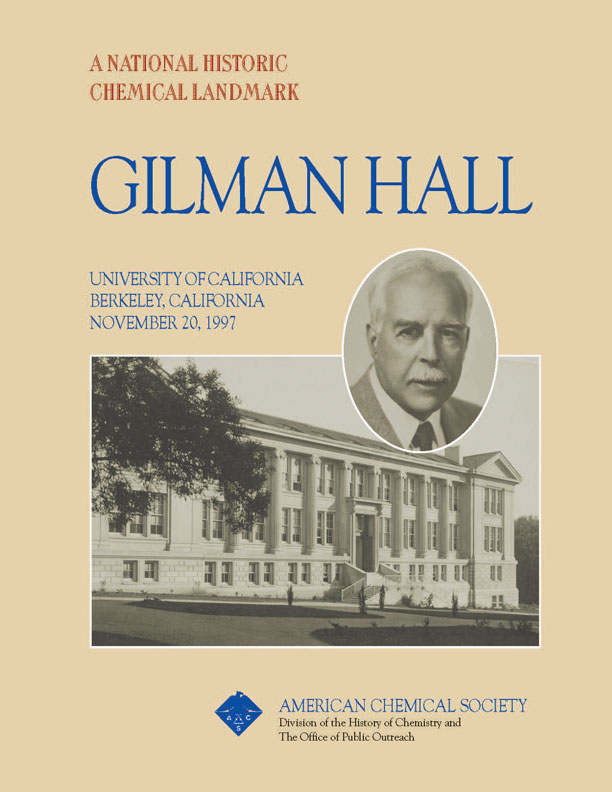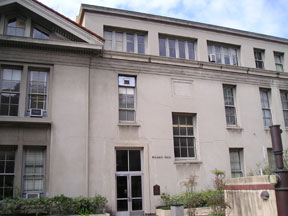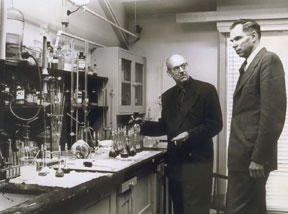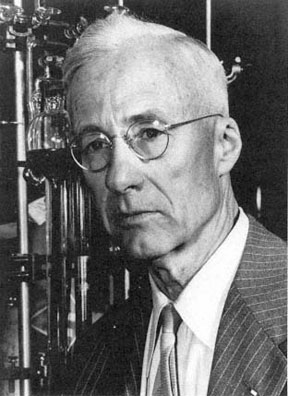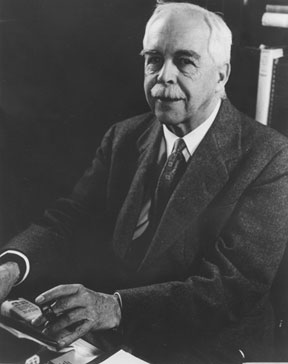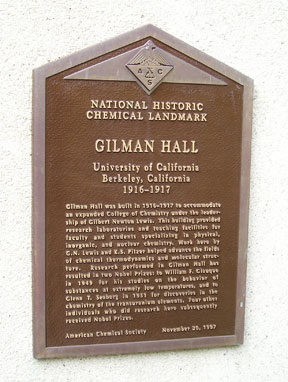Gilman Hall at the University of California, Berkeley
Dedicated November 20, 1997, at the University of California, Berkeley, in Berkeley, California.
Gilman Hall, built in 1916-1917, accommodated a growing College of Chemistry by providing expanded research and teaching facilities for faculty and students specializing in physical, inorganic and nuclear chemistry. Work performed at Gilman Hall helped advance the fields of chemical thermodynamics and molecular structure, and has resulted in multiple Nobel Prizes.
Contents
Gilman Hall at the University of California, Berkeley
The new chemistry building at the University of California, Berkeley, Gilman Hall, was dedicated in March 1918 as part of the University's "Semicentenary Week." In December 1911, Gilbert Newton Lewis, a well-established professor at the Massachusetts Institute of Technology (MIT), had visited Berkeley and had stated his conditions for coming to head the College of Chemistry. These conditions called for an enlarged budget and increases in faculty and staff for the Department of Chemistry, then the only department in the College of Chemistry, and for an annex to be added to the old red-brick chemistry building. Lewis came to Berkeley in 1912. He supervised the enlargement of the department, and a modest annex was built for him. He also started planning for the "ultimate chemistry laboratory." In 1917, Lewis' building, a modern steel and concrete structure, was completed and named Gilman Hall. It was devoted exclusively to research and instruction in physical and technical chemistry.
Gilman Hall was named for Daniel Coit Gilman, president of the university from 1872 to 1875. It was designed by John Galen Howard as a two-story building with a full basement largely above-ground.
Gilman Hall also had a small subbasement, which was occupied by a liquid air plant. The first such plant at Berkeley, built in about 1904 or 1905, was inadequate to support Lewis' strong interest in thermodynamics, especially the Third Law; the subbasement was added later to the building plans, specifically for this purpose.
There was also an extra floor, called the "attic," where much of the important research has been done. Room 307 in the attic was declared a National Historic Landmark in 1966; it is where plutonium was identified as a new element in 1941.
For any chemistry postdoctoral or graduate student from the Lewis era, the most storied room was number 102, where seminars were held. Lewis, filling the room with cigar smoke as was his custom, contributed to the research of all those present. He was an intellectual leader in what has become the American style of mentoring. He was strong, but he encouraged contributions from all those present as long as they were not foolish. It was this style that helped mold many of the leading physical chemists of his time.
In the period after 1918, significant research developments in physical chemistry shifted from Germany to the United States with a great deal of this advancement taking place under the leadership of Lewis in Gilman Hall.
Lewis' tenure in Gilman Hall was a period of great accomplishment that still influences the teaching and practice of chemistry.
Early Chemical Research Programs at Berkeley
Thermodynamics Research
The extensive research program in chemical thermodynamics envisioned by Lewis required research with materials at very low temperatures. To support this work, Wendell M. Latimer set up a liquid hydrogen facility in the Gilman Hall basement. Completed in 1921, it was the first in the United States. Latimer had received his Ph.D. at Berkeley in 1917, working with George Ernest Gibson, one of Lewis's first Berkeley hires and the research director for many doctoral students. Latimer is best known for organizing thermodynamic data for inorganic chemistry in his 1938 book, The Oxidation States of the Elements and Their Potentials in Aqueous Solution, and for his later leadership in the College of Chemistry.
In the early 1930s, Giauque's student J. W. Kemp made heat capacity measurements on frozen and liquid ethane, but the data were not interpreted until Kenneth S. Pitzer came to Berkeley from the California Institute of Technology (Caltech) in 1935 to work on thermodynamics with Latimer. When Pitzer learned of the ethane data, he and Kemp set about using these data to determine the barrier to the internal rotation of adjacent methyl groups. This work was the start of numerous papers by Pitzer on internal rotation and the thermodynamic properties of hydrocarbons.
Electrochemical measurements were another way to establish thermodynamic properties. Merle Randall, who came with Lewis from MIT, and E. D. Eastman, an early Lewis student, worked with Latimer in a Gilman Hall laboratory specifically designed for such measurements.
While the faculty who did organic or analytical research worked in the old chemistry building, a small group of inorganic or general physical chemists were working in Gilman Hall. The best known was Joel H. Hildebrand, who researched the theory of solutions. Hired by Lewis in 1913 to revamp first-year chemistry classes, he directed freshman chemistry instruction for nearly 40 years. His views on chemical education were widely respected.
Another respected Lewis hire, William C. Bray, also came to Berkeley from MIT. He pursued research in chemical kinetics and directed many students, including Henry Taube, who received the Nobel Prize in Chemistry in 1983. Axel R. Olson, also a faculty member working in Gilman Hall, was an early Lewis student who worked primarily in chemical kinetics. He also studied X-ray-induced plant mutations.
Nuclear Chemistry
Gibson, Latimer and Lewis were all interested in nuclear chemistry, and Lewis strongly supported the hiring of E. O. Lawrence by the physics department in 1928. In 1933, Robert D. Fowler and Willard F. Libby were the first nuclear chemists added to the chemistry faculty. Libby had received his Ph.D. with Latimer in 1933; he built one of the first Geiger counters in the U.S. and stayed on as a faculty member until leaving for war work in 1942. In 1960, Libby received the Nobel Prize in Chemistry for carbon-14 dating.
The nuclear people often worked in a wooden building, called the Old Radiation Laboratory, built for early Lawrence cyclotrons, just north of Gilman Hall; or they worked in the old annex, which had been built for Lewis. The other nuclear faculty included Samuel Ruben, Joseph W. Kennedy and Glenn T. Seaborg, all appointed in 1939. Ruben and M. D. Kamen, a physics student, first reported the preparation of carbon-14 in 1941. Their work on photosynthesis was halted by Ruben's untimely death in 1943.
Seaborg received his Ph.D. with Gibson in 1937 on the topic of neutron interactions and then worked with Lewis on generalized acids and bases for two years while pursuing his interest in nuclear chemistry. Seaborg, working with Kennedy, Edwin M. McMillan of the physics faculty and Arthur C. Wahl, identified the first known isotope of plutonium in room 307 of Gilman Hall in February 1941. This discovery was followed by the preparation of a new fissile isotope of uranium (U-233) by Seaborg, J. W. Gofman and R. W. Stoughton.
UC Berkeley Chemistry, World War II and Beyond
In 1942, the Berkeley campus became quite involved in the war effort of World War II. The top floor, or "attic," of Gilman Hall was fenced off for classified work in nuclear chemistry. Half of the rooms in the attic had small balconies that could be used as outdoor hoods, but the actual hoods in Gilman Hall were not equipped with fans. They operated only as chimneys, with a burner flame that produced a draft. For the war work, electrically powered fans were finally installed to vent the hoods.
Plutonium research in Gilman Hall, directed by Eastman and Latimer, was part of the Manhattan Project to develop the atomic bomb. The majority of the workers on these projects were recent Berkeley Ph.D.s, including John W. Gofman, Robert E. Connick and Leo Brewer.
In 1942, Glenn Seaborg left Berkeley to join the Manhattan Project in Chicago. He returned to Berkeley after the war and directed the university's nuclear chemistry research. He shared the 1951 Nobel Prize in Chemistry with McMillan for their discoveries in the chemistry of the transuranium elements.
Following Lewis's retirement from administration in 1941, Latimer became dean of the College of Chemistry, a position he held until 1949. He persuaded Melvin Calvin, a physical-organic faculty member who had worked with Lewis, to resume Ruben and Kamen's research on the use of carbon-14 as a tracer in photosynthesis. Calvin established his headquarters in the Old Radiation Laboratory. In 1961, he received the Nobel Prize for his studies in photosynthesis. Latimer was dean when the Division of Chemical Engineering was established in 1946 in Gilman Hall. With the support of Hildebrand and Pitzer, who followed him as deans, chemical engineering became a full department in 1957.
As the chemistry department grew and moved into newer facilities, the chemical engineering department expanded to occupy all of Gilman Hall. By 1948, the famous seminar room, 102, was too small for research conferences, and it was remodeled into administrative space. The attic rooms are still used for chemical engineering research, but most of the shops have been moved. The subbasement has been remodeled into an undergraduate chemical engineering laboratory.
Even after the addition of more modern buildings, Gilman Hall remains a central part of the College of Chemistry. It is a well-designed, skillfully constructed building. In California, where buildings are rated for earthquake hazards, Gilman Hall has about the same rating as most of the campus buildings built 50 years later. The symbol of the westward movement of science and technology, Gilman Hall continues to serve the purpose for which it was built — education and research in the chemical sciences.
Biography of Gilbert Newton Lewis
G. N. Lewis was respected by knowledgeable contemporaries for his writing and the excellence of his research, but valued as much for his clear thinking, his scholarly enthusiasm, and his ability to lead other scientific thinkers.
Lewis was born in Weymouth, Massachusetts, in 1875, but spent much of his youth in Lincoln, Nebraska. After being schooled at home, he was admitted in 1889 to a preparatory school associated with the University of Nebraska. He entered Harvard College in 1893 and received an A.B. degree in 1896. Following a year of teaching at the Phillips Academy in Andover, he returned to Harvard and received his A.M. degree in 1898 and his Ph.D. in 1899, under T. W. Richards. He spent one year as an instructor at the college and then studied in Germany with F. W. Ostwald and H. W. Nernst, before returning for three more years as an instructor at Harvard.
Lewis was not satisfied with the research atmosphere at Harvard. Wanting time to consider his future, he took a position in the Philippines for one year to work in the Bureau of Science. When he returned in 1905, he was invited to the Massachusetts Institute of Technology by A. A. Noyes, who had been a student of Ostwald£s. Lewis spent seven years at MIT, where he published 30 papers and rose to a full professorship.
When Lewis came to Berkeley in 1912, his first laboratories were in a temporary wooden building. Awaiting state bond money, the construction of Gilman Hall was delayed until 1916, and was first occupied in September 1917. Gilman Hall's next quarter century came to be known as the G. N. Lewis era.
At times, Lewis spent his weekdays on campus, using a small bedroom and shower in a Gilman Hall attic room, while his family lived in the country. After the university ruled against living in its research buildings, Lewis moved into the nearby Faculty Club.
Lewis was rarely in the classroom, but his weekly research seminar set the standard for the College of Chemistry. Two hundred and ninety Ph.D.s were granted under Lewis and his colleagues. He worked with great intensity and had a series of research assistants for experimental work. He took only a few graduate students, although many other students worked with younger faculty on projects within Lewis' broad area of interest.
G. N. Lewis' publications covered, among other things, relativity, natural radioactivity, refraction of neutrons, acid-base properties, and classical and statistical thermodynamics. He is often quoted as having said that "physical chemistry is anything which is interesting." Most chemists remember Lewis best for his octet theory and the electron-pair bonding diagrams, which he first published in 1916, and for the generalized theory of acids and bases, which bears his name. His most famous book, Thermodynamics and the Free Energy of Chemical Substances, written with Merle Randall, was published in 1923.
Harold C. Urey (a 1923 UC-Berkeley Ph.D., and 1934 Nobel laureate) had discovered deuterium at Columbia University in 1932. Lewis actively pursued the new field of deuterium chemistry, and between 1932 and 1934, he published more than 25 papers on the topic. Later in the 1930s, Lewis returned to the theories of acids and bases, and a 1938 lecture at the Franklin Institute "did much to make the Lewis acid an important part of chemical theory."
Responding to the increased popularity of the field of photochemistry in the 1930s, Lewis published, with Melvin Calvin, a long review of the theory of color. Lewis continued his studies of fluorescence and phosphorescence and published several important papers about quantum theory.
On March 23, 1946, Gilbert Newton Lewis died in his Gilman Hall laboratory, while carrying out an experiment on fluorescence.
Further Reading
- The College of Chemistry: A Brief History (University of California, Berkeley)
- Gilbert Norton Lewis (Chemical Heritage Foundation)
Landmark Designation and Acknowledgments
Landmark Designation
The American Chemical Society designated Gilman Hall at the University of California, Berkeley as a National Historic Chemical Landmark on November 20, 1997. The plaque commemorating the event reads:
Gilman Hall was built in 1916-1917 to accommodate an expanded College of chemistry under the leadership of Gilbert Newton Lewis. This building provided research and teaching facilities for faculty and students specializing in physical, inorganic, and nuclear chemistry. Work here by G. N. Lewis and Kenneth S. Pitzer helped advance the fields of chemical thermodynamics and molecular structure. Research performed in Gilman Hall has resulted in two Nobel Prizes: to William F. Giauque in 1949 for his studies on the behavior of substances at extremely low temperatures, and to Glenn T. Seaborg in 1951 for discoveries in the chemistry of the transuranium elements. Four other individuals who did research here subsequently received Nobel Prizes.
Acknowledgments
Adapted for the internet from “Gilman Hall,” produced by the National Historic Chemical Landmarks program of the American Chemical Society in 1997.
Learn more: About the Landmarks Program
Take action: Nominate a Landmark and Contact the NHCL Coordinator

